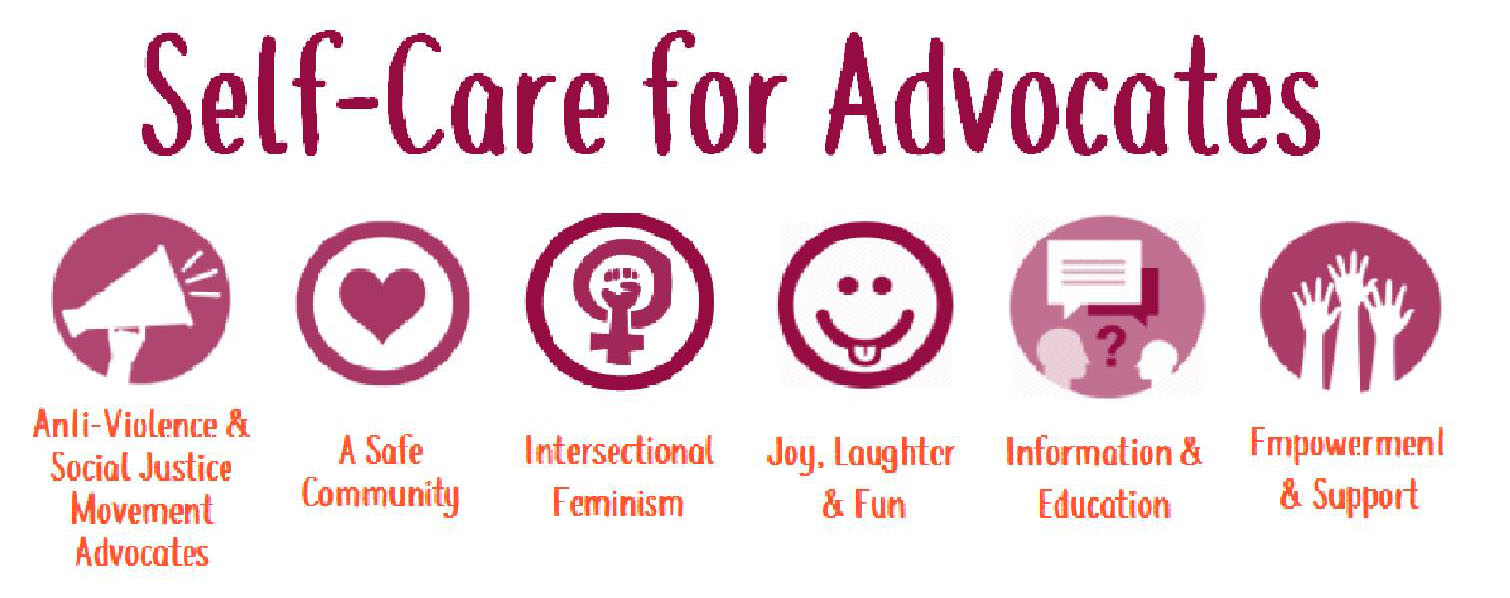by Breckan Erdman, NRCDV Senior Program Specialist
I recently read The Sum of My Parts, Olga Trujillo’s powerful memoir about her experiences with childhood trauma and dissociative identity disorder, for a book club with a small group of friends and Olga herself. It is beautiful, yet incredibly raw and can be quite challenging to get through.
In the days leading up to the book club, a few of us noticed changes in our sleep and cognitive patterns in ways that resembled the effects of vicarious trauma. We looked forward to the opportunity to gather with the group to share our experiences reading the book and to talk with Olga and see for ourselves that she is doing well. The meeting did not disappoint. After feeling like we’d walked through her trauma with her, bearing witness to Olga’s resilience was truly a gift.
By the time I got home from the book club, I felt exhausted and overwhelmed with emotions, and I could hear my inner “wellness warrior” reminding me to take care of myself. So I did my typical self-care activities that help me to feel nourished “physically, emotionally, spiritually, all of the above”: I made myself some tea, grabbed a blanket, and curled up on the couch with my partner and our cat as we watched a mindless sitcom on Netflix. I don’t think I even made it through a full episode of our show before I’d fallen asleep.
I would love to tell you that doing my self-care routine untangled all of those complex emotions, but of course it did not. Nonetheless, setting aside time to take care of myself that night helped me feel a lot less emotionally drained than I had been feeling all week. As the saying goes, you can’t pour from an empty cup.
Ideally, we would all take excellent care of ourselves all the time, but when we’re feeling the effects of vicarious trauma, it becomes particularly crucial to tend to our immediate wellbeing if we are to promote the long-term sustainability of our work. Self care can mean different things for different people, but as advocates it is important that we find ways to connect, celebrate, grieve, and heal.
For advocates from historically marginalized communities who are inundated with racism and other forms of structural oppression, self-care is even more critical. Feeling isolated in predominantly white workplaces, being undervalued by supervisors, and experiencing constant microagressions from coworkers can take a particularly heavy toll. In the words of Audre Lorde, “caring for myself is not self-indulgence, it is self-preservation, and that is an act of political warfare.”
In this and any movement, people are the tools for making change – we must invest in ourselves as the key resources that we are.
How Vicarious Trauma Shows Up
The Office for Victims of Crimes defines vicarious trauma as a negative reaction to trauma exposure, such as “listening to individual clients recount their victimization; looking at videos of exploited children; reviewing case files; hearing about or responding to the aftermath of violence and other traumatic events day after day; and responding to mass violence incidents that have resulted in numerous injuries and deaths.” The phrase “vicarious trauma” is sometimes used interchangeably with related terms, such as compassion fatigue and secondary traumatic stress, which have distinct and overlapping definitions.
Vicarious trauma can show up in a variety of ways, both in our bodies and in our minds. Symptoms can include:
- Emotional problems, such as difficulty managing emotions, feeling numb or shut down, or increased irritability
- Physical problems, such as aches, fatigue, disrupted sleep patterns, or decreased resistance to illness
- Hopelessness about the future or loss of a sense of meaning
- Relationship problems, such as withdrawing from friends and family or avoiding intimacy
- Avoiding work and interactions with clients or constituents
Over time, exposure to vicarious trauma can contribute to burnout, taking a toll on our work and our mental and physical wellbeing.
Emotional First-Aid
First things first, let’s make sure that your basic needs are met. Have you eaten recently? Had some water? Do you need rest? If so, do you have a safe place to rest? Once these needs are met, you can get on with nurturing yourself.
Needless to say, bubble baths, herbal tea, and all of the other soothing activities that we typically think of when we hear the phrase “self-care” can be valuable tools to help us relax. If you are feeling anxious, be sure to set aside some time for reliable relaxation techniques such as coloring, aromatherapy, breathing exercises, or another soothing activity you enjoy. Any number of lists of self-care strategies are available online if you need help coming up with ideas.
Alternately, if you feel like you’d benefit more from an emotional boost than from self-soothing, try to connect with a loved one! Our communities are great assets to our wellbeing, so visit a buddy, call a family member, or get in touch with a friend you haven’t talked to in a while. Remember, your work requires you to feed and nurture others to build stronger, healthier communities – this is not, nor was it ever intended to be, a one-way street. Dr. Isaac Prilleltensky of the University of Miami researches the science of mattering and its connection to our well-being. His findings indicate that a reciprocal relationship between the value we add to our communities and the value we derive from them leads to true well-being, through connectedness.
If this feels like just another thing to add to your to-do list, see if you can find ways to build “self-care” into your life so it doesn’t feel like something extra. Can you create spaciousness in your day by not scheduling meetings back-to-back? What boundaries can you set in your work and personal life to promote your wellbeing? For many of us, time is often a luxury—the last thing you need is to feel more stressed by the prospect of taking care of yourself.
Long-Term Sustainability
While taking time to nurture yourself is essential, deep breathing alone won’t create the more equitable and just world that we all wish to live in. Research indicates that helping professionals who lack a connection to a sense of hope and purpose for their work are at greater risk for experiencing vicarious trauma. This means that fighting for social justice is an act of self-care, as it can help us stay connected to the bigger picture.
Most of us came to this work because we want to make the world a better place in one way or another. If work is draining you, look for ways to take action beyond your job, whether that means getting plugged into other social justice movements, teaching your children and family members to be socially conscious, or even lobbying for legislation that will positively impact survivors in your community. Seeing positive changes in our communities can encourage us to feel more hopeful and can help fuel the passion that brought us to this work in the first place. Ivonne Ortiz reminds us that as advocates, “we must intentionally strive to be messengers of hope, community reconcilers, justice-makers, and healers at the same time that we encourage our communities to look within themselves and find those strengths that have carried them on for generations.”
One of the amazing things about working in the movement to end gender-based violence is that while vicarious trauma can be a very real threat to our mental health and overall wellbeing, evidence suggests that vicarious resilience can influence us as well. Bearing witness to the incredible resilience of trauma survivors can have a profoundly positive impact on our own attitudes and emotions and can help sustain us as we do the work that we’re passionate about.
Structuring our lives in ways that promote self-perseverance and showing ourselves extra love when we notice red flags can prevent burnout and help us bring our fullest selves to the work. When we come to the work from a place of wholeness and wellbeing, the movement benefits. For additional reading on helpful strategies for mitigating the negative effects of vicarious trauma, check out:
- Vicarious Trauma Toolkit: This toolkit from the Office for Victims of Crime was designed to help victim services, emergency medical services, and other organizations become vicarious trauma-informed. It offers information on how organizations can support their staff, as well as resources for supervisors, coworkers, and loved ones of helping professionals who are at risk for vicarious trauma.
- Trauma Stewardship: An Everyday Guide to Caring for Self While Caring for Others: This book by longtime trauma worker Laura van Dernoot Lipsky offers valuable insight on self-care for advocates and others who work with trauma survivors.
- Move to End Violence’s 21-Day Self-Care Challenge: Sign up to receive daily self-care prompts to help you become more aware of your self-care habits and to begin to shift those habits into more sustainable practices.
- 3 Things You Should Know About Intersectionality and Self-Care: This insightful article from Rex Leonowicz challenges mainstream discourse about “self-care” and offers strategies for grounding self-care in intersectionality.
- Self-Care for Advocates: This Facebook group provides a safe, feminist space for anti-violence advocates to support each other by sharing self-care strategies.
















